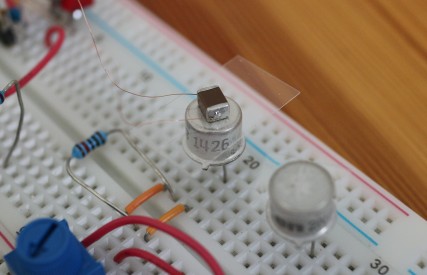Got a tube scanner in the mail today! I paid $100 for it from Boston Piezo Optics, which seemed pretty good. If you want to get a tube from them, just make sure you get one that’s in stock as it will be much cheaper.
As I am more interested in high resolution than large scan ranges, I got a small, rigid tube with 0.25″ OD, 0.50″ length, and 0.025″ wall thickness. Dielectric material is PZT-5A. I’m going to design a new scan head for it, and include a stepper motor-driven coarse approach mechanism. Of course, i’ll also need to build a high-voltage amplifier to drive the tube scanner.
So how will this compare to the unimorph disc? My disc scanner has about 700 nm Z-travel and 1700 nm XY-travel, and about a 3.4 kHz resonant frequency. The Z-axis displacement Δz of a tube scanner can be calculated as follows [1]:
where L is the length of the scanner (0.50″), d31 is the piezoelectric constant (173 pm/V for PZT-5A), V is the applied voltage, and t is the wall thickness. This gives about 1 um for my tube with a 250 V range. We can also calculate XY displacement:
which gives 1.7 um for my tube, so in terms of range, this tube is pretty similar to the unimorph disc, but requires much higher voltages. The big difference is in rigidity. This tube should have an extensional resonant frequency around ~30 kHz for a 1 g load [2], which should give a huge improvement in terms of scan speed and vibration tolerance.
[1] EBL Products has some useful information on tube scanners, including material properties and displacement formulae.
[2] Tetsuo Hanaguri has a spreadsheet to calculate scan tube resonant frequencies.



